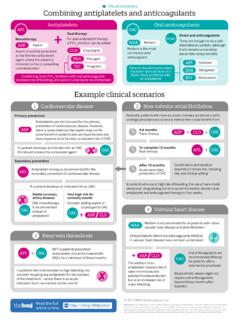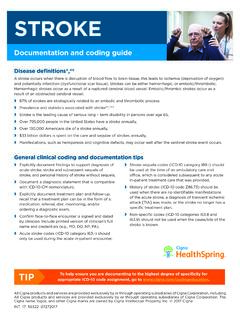Transcription of Dizziness: Approach to Evaluation and Management
1 154 American Family Physician Volume 95, Number 3 February 1, 2017 Dizziness is a common yet imprecise symptom. It was traditionally divided into four categories based on the patient s history: vertigo, presyncope, disequilibrium, and light-headedness. However, the distinction between these symp-toms is of limited clinical usefulness. Patients have difficulty describing the quality of their symptoms but can more consistently identify the timing and triggers. Episodic vertigo triggered by head motion may be due to benign parox-ysmal positional vertigo. Vertigo with unilateral hearing loss suggests Meniere disease.
2 Episodic vertigo not associated with any trigger may be a symptom of vestibular neuritis. Evaluation focuses on determining whether the etiology is peripheral or central. Peripheral etiologies are usually benign. Central etiologies often require urgent treatment. The HINTS (head-impulse, nystagmus, test of skew) examination can help distinguish peripheral from central etiologies. The physical examination includes orthostatic blood pressure measurement, a full cardiac and neurologic examina-tion, assessment for nystagmus, and the Dix-Hallpike maneuver. Laboratory testing and imaging are not required and are usually not helpful.
3 Benign paroxysmal positional vertigo can be treated with a canalith repositioning procedure ( , Epley maneuver). Treatment of Meniere disease includes salt restriction and diuretics. Symptoms of vestibu-lar neuritis are relieved with vestibular suppressant medications and vestibular rehabilitation. (Am Fam Physician. 2017 ;95(3):154 -162. Copyright 2017 American Academy of Family Physicians.)Dizziness: Approach to Evaluation and ManagementHERBERT L. MUNCIE, MD, Louisiana State University School of Medicine, New Orleans, LouisianaSUSAN M. SIRMANS, PharmD, University of Louisiana at Monroe School of Pharmacy, Monroe, LouisianaERNEST JAMES, MD, Louisiana State University School of Medicine, New Orleans, LouisianaDizziness is a common yet im precise symptom often en coun tered by family physicians.
4 Primary care physicians see at least one half of the patients who present with The differential diagnosis is broad, with each of the common etiologies accounting for no more than 10% of cases2 (Ta b l e 11,3). Because the symptoms are vague, physicians must distinguish benign from se rious causes that require urgent Evaluation and was traditionally classified into four categories based on the patient s description: (1) vertigo, (2) presyncope, (3) disequilibrium, and (4) light However, current approaches do not include presyncope and do not use the vague term light Patients often have dif ficulty describing their symptoms and may give conflicting accounts at different Symptom quality does not reliably predict the cause of Physicians are cau tioned against overreliance on a descriptive Approach to guide the diagnostic evalua Alternatively, attention to the timing and triggers of dizziness is preferred over the symptom type because patients more consis tently report this.
5 7 General Approach Questions regarding the timing (onset, duration, and evolution of dizziness) and triggers (actions, movements, or situations) that provoke dizziness can categorize the dizziness as more likely to be peripheral or central in etiology. Findings from the physi cal examination can help confirm a probable diagnosis. A diagnostic algorithm can help determine whether the etiology is peripheral or central (Figure 1) .TITRATE THE EVALUATIONTiTrATE is a novel diagnostic Approach to determining the probable etiology of diz ziness or The Approach uses the Timing of the symptom, the Triggers that provoke the symptom, And a Targeted Examination.
6 The responses place the diz ziness into one of three clinical scenarios: episodic triggered, spontaneous episodic, or continuous This clinical content conforms to AAFP criteria for continuing medical education (CME). See CME Quiz Questions on page disclosure: No rel-evant financial affiliations. Patient information: A handout on this topic, written by the authors of this article, is available at from the American Family Physician website at Copyright 2017 American Academy of Family Physicians. For the private, noncom-mercial use of one individual user of the website. All other rights reserved.
7 Contact for copyright questions and/or permission 1, 2017 Volume 95, Number 3 American Family Physician 155 With episodic triggered symptoms, patients have brief episodes of intermittent dizziness lasting seconds to hours. Common triggers are head motion on change of body position ( , rolling over in bed). Episodic triggered symptoms are consistent with a diagnosis of benign paroxysmal positional vertigo (BPPV).With spontaneous episodic symptoms (no trigger), patients have episodes of dizziness lasting seconds to days. Because these epi sodes have no trigger, the patient s history establishes the diagnosis.
8 Common diagnos tic considerations for spontaneous episodic symptoms include Meniere disease, vestibu lar migraine, and psychiatric diagnoses such as anxiety disorders. Symptoms associated with lying down are more likely continuous vestibular symptoms, patients have persistent dizziness lasting days to weeks. The symptoms may be due to traumatic or toxic exposure. Classic vestibu lar symptoms include continuous dizziness or vertigo associated with nausea, vomiting, nystagmus, gait instability, and head motion intolerance. In the absence of trauma or exposures, these findings are most consistent with vestibular neuritis or central etiologies.
9 However, central causes can also occur with patterns triggered by : TIMING, TRIGGERS, AND MEDICATIONSP atients who describe a sensation of self motion when they are not moving or a sensa tion of distorted self motion during normal head movement may have Ve r t i go is the result of asymmetry within the ves tibular system or a disorder of the peripheral labyrinth or its central ,9 The SORT: KEY RECOMMENDATIONS FOR PRACTICEC linical recommendationEvidence ratingReferencesVertigo associated with unilateral hearing loss should raise suspicion for Meniere The physical examination in patients with dizziness should include orthostatic blood pressure measurement, nystagmus assessment, and the Dix-Hallpike maneuver for triggered The HINTS (head-impulse, nystagmus, test of skew) examination can help differentiate a peripheral cause of vestibular neuritis from a central cause.
10 C20 Laboratory testing and imaging are not recommended when no neurologic abnormality is found on paroxysmal positional vertigo is treated with a canalith repositioning procedure ( , Epley maneuver).A30 Vestibular neuritis symptoms may be relieved with medication and vestibular disease may improve with a low-salt diet and diuretic A = consistent, good-quality patient-oriented evidence; B = inconsistent or limited-quality patient-oriented evidence; C = consensus, disease-oriented evidence, usual practice, expert opinion, or case series. For information about the SORT evidence rating system, go to 1.















